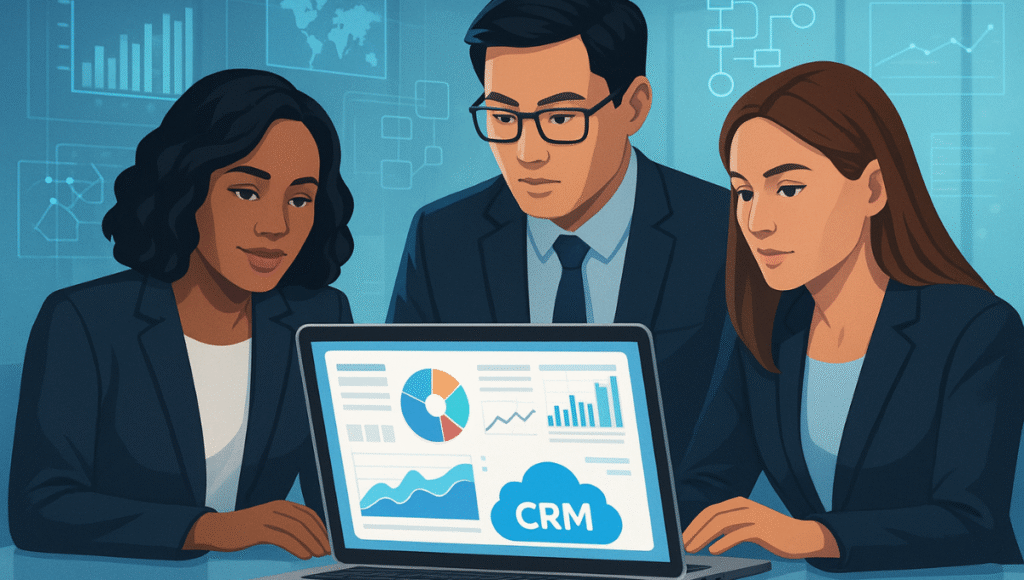
Salesforce has spent decades building the world’s leading customer relationship management (CRM) platform. But growth hasn’t come just from internal development. The company has made over 65 acquisitions since its founding in 1999, spending more than $50 billion to bring new capabilities under one roof.
These purchases weren’t random. Each one filled a specific gap, whether in analytics, collaboration, integration, or industry-specific tools. Let’s break down the 10 biggest Salesforce acquisitions that shaped the platform into what it is today.
Before we look at individual deals, it helps to understand the strategy. Salesforce doesn’t acquire companies just to expand. The goal is to close capability gaps and create a more complete experience for users.
Take data visualisation, for example. Salesforce could have spent years building its own analytics platform from scratch. Instead, it bought Tableau, the market leader, and integrated those tools directly into its ecosystem. The same logic applies to collaboration tools, integration platforms, and industry-specific solutions.
For businesses working with Salesforce partners like Sailwayz, these acquisitions matter. They mean more native features, better integration options, and stronger capabilities across sales, service, and marketing functions.
This is the big one. Salesforce paid $27.7 billion for Slack in December 2020, making it the second-largest software acquisition ever (after IBM’s purchase of Red Hat). The deal closed in July 2021.
Slack changed how teams communicate at work. Instead of endless email threads, people could message in channels, share files, and integrate with other tools. More than 156,000 organisations used Slack before Salesforce stepped in.
Why did Salesforce want it? The company had been pushing “Social Enterprise” since 2009 with its Chatter tool, but that never caught on the way Slack did. By buying Slack, Salesforce positioned itself to compete with Microsoft Teams and created what it calls a “digital headquarters” for businesses.
The integration makes sense. You can now receive Salesforce alerts in Slack, collaborate on deals without leaving your conversation thread, and connect your CRM data with daily workflows. For companies using Salesforce implementation services, this means smoother internal communication tied directly to customer data.
Before Tableau, Salesforce had analytics tools, but they weren’t industry-leading. Tableau changed that. The company paid $15.7 billion in August 2019 to acquire the data visualisation platform used by thousands of organisations worldwide.
Tableau made complex data accessible. Users could create interactive dashboards, spot trends, and share insights without needing a data science degree. Salesforce saw an opportunity to bring those capabilities to its entire customer base.
The impact was immediate. Salesforce rebranded Einstein Analytics to Tableau CRM, combining artificial intelligence with powerful visualisation tools. Businesses could now turn their CRM data into actionable insights with drag-and-drop simplicity.
For Sailwayz clients working with Sales Cloud or Service Cloud, Tableau integration means better reporting, faster decision-making, and clearer visibility into performance metrics.
Legacy systems don’t play well together. MuleSoft solved that problem, and Salesforce paid $6.5 billion in May 2018 to make it part of the platform.
MuleSoft specialises in integration. Its Anypoint Platform connects applications, data sources, and devices across cloud and on-premises environments. Think of it as a universal translator for enterprise software.
This acquisition made Salesforce more than just a CRM. It became a hub that could connect to almost anything. Companies could link Salesforce to ERP systems, legacy databases, custom applications, and third-party tools without writing endless custom code.
The MuleSoft deal showed Salesforce was serious about becoming the central platform for all customer data, not just the stuff that lives inside Salesforce itself.
E-commerce was the next frontier, and Demandware was Salesforce’s entry ticket. The company paid $2.8 billion in July 2016 to acquire the cloud-based e-commerce platform.
Demandware powered online stores for major brands like Adidas, Puma, and Lands’ End. It handled everything from product catalogues to checkout processes to mobile shopping experiences.
After the acquisition, Salesforce created Commerce Cloud, connecting e-commerce with CRM data. Retailers could now see the full customer journey, from browsing behaviour to purchase history to service interactions, all in one place.
This matters for businesses working with Salesforce consultants because it created true omnichannel experiences. A customer could start shopping on mobile, continue on desktop, and finish in-store, with all that data flowing back into Salesforce.
Back in 2013, ExactTarget was Salesforce’s largest acquisition to date at $2.5 billion. The deal closed in July 2013 and put Salesforce firmly in the marketing automation space.
ExactTarget provided email marketing, social media management, and mobile marketing tools to more than 6,000 companies, including Coca-Cola, Gap, and Nike. It helped marketers manage campaigns, track results, and engage customers across multiple channels.
Salesforce rebranded ExactTarget as Marketing Cloud in 2014. The platform became a cornerstone for digital marketing, letting businesses create personalised customer journeys from first contact to final purchase.
For companies implementing Salesforce with partners like Sailwayz, Marketing Cloud integration means sales and marketing teams can finally work from the same data, eliminating silos and improving campaign performance.
Data protection became a priority, and Own (formerly OwnBackup) was the answer. Salesforce paid $1.9 billion in September 2024 to acquire the data management firm.
Own specialises in backup, recovery, and data security for Salesforce environments. When companies accidentally delete records, face ransomware attacks, or need to comply with regulations, Own ensures they can restore their data quickly.
This acquisition strengthened Salesforce’s data protection capabilities beyond basic features. Own’s tools work across Salesforce, AWS, and Microsoft applications, providing comprehensive data resilience and compliance support.
The deal shows Salesforce recognises that customer data is its most valuable asset. Protecting that data isn’t just about security, it’s about maintaining trust and meeting regulatory requirements across industries.
Field service management needed an upgrade, and ClickSoftware delivered. Salesforce acquired the company for $1.35 billion in October 2019.
ClickSoftware had been in the field service space since 1997. Its platform helped companies manage mobile workforces, schedule appointments, optimise routes, and provide real-time updates to field technicians.
The acquisition boosted Service Cloud’s capabilities for businesses with field teams. Technicians could access customer history, inventory data, and job details from mobile devices. Dispatchers could optimise schedules based on location, skills, and availability.
For industries like utilities, telecom, and home services, this meant better first-time fix rates, shorter response times, and improved customer satisfaction.
Industry-specific solutions got a major boost when Salesforce acquired Vlocity for $1.33 billion in February 2020. The deal closed in June that year.
Vlocity built CRM solutions tailored to specific industries: communications, media, energy, utilities, insurance, health, and government. Instead of generic CRM tools, customers got features that spoke the language of their industry.
For example, insurance companies needed different workflows than telecommunications providers. Vlocity provided those industry-specific processes, and Salesforce turned them into what’s now called Salesforce Industries.
The acquisition showed Salesforce was moving beyond horizontal CRM into vertical solutions. Companies in specialised industries could implement Salesforce faster because the tools already understood their unique requirements.
Marketing intelligence got smarter with Datorama. Salesforce acquired the platform for $800 million in August 2018, bringing advanced marketing analytics into the fold.
Datorama helped marketers make sense of data from dozens of sources. It connected advertising platforms, social media, email campaigns, and website analytics into unified dashboards.
The platform used AI to spot trends, identify underperforming campaigns, and suggest optimisations. Marketers could finally answer questions like “Which channels drive the most revenue?” and “Where should we shift our budget?”
Salesforce rebranded Datorama as Marketing Cloud Intelligence in 2022, making it a core part of the marketing analytics suite.
Data management platforms became essential for marketers, and Krux led that category. Salesforce paid $700 million in October 2016 to acquire the company.
Krux specialised in collecting, organising, and activating customer data for advertising and marketing campaigns. It helped brands understand audience behaviour across websites, mobile apps, and connected devices.
After the acquisition, Salesforce turned Krux into Audience Studio (now called Data Studio), giving marketers tools to create targeted segments, personalise content, and optimise ad spending based on real customer data.
This acquisition strengthened Marketing Cloud’s ability to deliver personalised experiences at scale, particularly for consumer-facing brands with complex audience segmentation needs.
These 10 deals represent more than $58 billion in investments. But what does it actually mean for the businesses using Salesforce?
First, you get more functionality without switching platforms. Instead of cobbling together five different tools from five different vendors, you can manage collaboration, analytics, marketing, e-commerce, and field service all within Salesforce.
Second, integration becomes simpler. When Salesforce owns the technology, it can build deeper connections between products. Data flows more smoothly, and you spend less time fighting with APIs.
Third, you benefit from continued development. Salesforce invests heavily in acquired companies, adding features, improving performance, and expanding capabilities over time.
For businesses working with Salesforce partners, these acquisitions create new opportunities. Whether you’re implementing Marketing Cloud, building custom integrations with MuleSoft, or deploying field service solutions, the expanded ecosystem gives you more tools to solve business problems.
Will Salesforce keep buying companies? Almost certainly. The pattern over the past decade shows a clear strategy: identify gaps, acquire leaders, integrate quickly.
Recent purchases in 2024 and 2025 focused on data management, AI, and content. Expect that trend to continue as Salesforce pushes into agentic AI, knowledge management, and personalisation at scale.
For businesses already using Salesforce, staying informed about acquisitions helps you plan implementations. When Salesforce buys a company in your industry or with features you need, you might want to accelerate adoption before prices change or products get rebranded.
Sailwayz is a certified Salesforce consulting and implementation partner helping businesses across industries maximise their CRM investments. From initial implementation to ongoing support, our team guides you through every stage of your Salesforce journey.
What was Salesforce’s largest acquisition?
Slack remains the largest Salesforce acquisition at $27.7 billion. The deal closed in July 2021 and brought workplace collaboration tools directly into the Salesforce ecosystem. It’s also the second-largest software acquisition in history, only behind IBM’s purchase of Red Hat for $34 billion.
Why does Salesforce acquire so many companies?
Salesforce uses acquisitions to fill capability gaps faster than building features from scratch. Instead of spending years developing analytics tools, for example, they bought Tableau, the market leader. This strategy accelerates innovation and gives customers proven solutions integrated into the platform they already use daily.
How many companies has Salesforce acquired?
As of 2024, Salesforce has acquired more than 65 companies since its founding in 1999. The pace of acquisitions increased significantly after 2010, with Salesforce making multiple purchases nearly every year to expand into marketing, analytics, integration, collaboration, e-commerce, and industry-specific solutions.
What happened to the companies Salesforce bought?
Most acquired companies get rebranded and integrated into Salesforce’s product suite. ExactTarget became Marketing Cloud, Tableau became Tableau CRM, and Demandware became Commerce Cloud. Some maintain their original names, like Slack, while others disappear entirely as their features get absorbed into existing products.
Does Salesforce own Tableau and Slack?
Yes, Salesforce owns both Tableau and Slack. It acquired Tableau in August 2019 for $15.7 billion and Slack in July 2021 for $27.7 billion. Both continue to operate as distinct products within the Salesforce ecosystem, with integrations that connect them to Sales Cloud, Service Cloud, and other Salesforce platforms.




Joshua Eze is the Founder & Salesforce Architect at Sailwayz, a certified Salesforce Consulting Partner based in the UK. With over 6 years of experience leading CRM transformations, he is a certified Application & System Architect passionate about using technology to simplify business processes. Joshua helps companies unlock the full potential of Salesforce with strategic, scalable, and secure solutions.